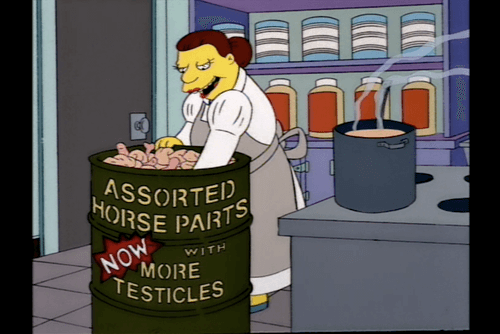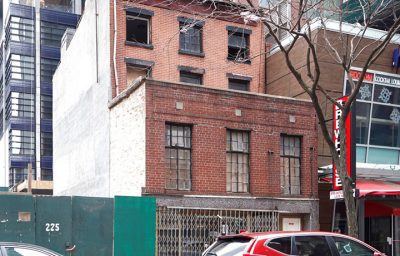New York City Public School Lunches Suck Because They Are For Poor Kids

Lunch Lady Doris assembling a typical American public school lunch: Now with more testicles!
One perennially popular media item is the breaking news that American public school lunches suck. I know! Not exactly shocking stuff to anyone who has ever eaten in a school cafeteria, is it? And yet, when I clicked through a recent slideshow on Fast Co. demonstrating school lunches from around the world and the “embarrassing” American equivalent, I started to get pretty incensed. The article accompanying the slideshow (which was sponsored by salad chain Sweetgreen) purports that the main barrier to getting kids better school lunches is education, and that if kids—and their parents, I suppose—only knew better about what to eat, then they would do so. In effect, the system as a whole—the schools, the parents, even the kids themselves—who are being tacitly blamed for the fact that “compared to their peers who bring lunch from home, [kids who eat school lunch are] fatter, eat fewer vegetables, and have higher cholesterol.” This is bullshit. The reason school lunches here aren’t very good is because they are designed to serve the most ignored segment of our population: Poor Americans.
Take the New York City public school system as an example. The majority of kids (68%) in New York’s public school system are eligible for free lunch, but by high school only 38% of students eat school lunch at all. In fact, only 61% of middle school students eat public school lunch, a steep decline from the 81% of elementary school students who do. But why the drop? Simple: Eating school lunch when there are other options available to you (students in all public high schools and many public middle schools are encouraged, if not mandated to eat lunch off school grounds) will label you as being poor.
The rise of foodie culture and the new kind of value placed on home-cooked, organic meals, has occurred in conjunction with school budgets being slashed and school cafeterias being transformed, in some cases, into places that don’t even have kitchens. As many New York public schools welcome more and more of the type of upper-middle class to flat-out wealthy families that used to either enroll their children in private schools or decamp for the suburbs, public school cafeterias have become an easy place as any other to observe economic disparities. This is less of a problem in elementary schools here, where many children go to their locally zoned schools, and are more frequently with kids of the same economic status, in effect equalizing the playing field. But middle school and high school are different, primarily here’s more consciousness of the stigma of poverty attached to getting school lunch, especially when there’s suddenly an option to eat off-site. It becomes obvious that the only kids who are eating school lunch are doing so because they have no other choice.
Recently, there have been efforts to combat this, notably by making middle school lunches free for all students, regardless of family income, this year. This program is certainly a great step in the right direction, though it isn’t going to solve the problem of the low quality of these lunches. What’s notable in other countries is that school lunch tends to be eaten by all kids, poor or not. (Of course, the reality that very few other countries have the kind of stark income inequality that exists in the New York City public school system, making for a dramatically uneven playing field to begin with, is another issue all together.) The bottom line, though, is that if you want to guarantee that public school lunch will improve in America, or even just New York City, there’s a pretty simple way to do it: Mandate that all students have to eat it, not just the ones who can’t afford to do otherwise.
Follow Kristin Iversen on twitter @kmiversen
You might also like 



















